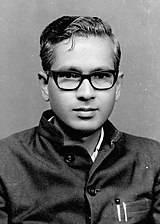Mulukanadu Brahmin
| Religion | |
|---|---|
Smarta tradition. |
The Mulukanadu Brahmins are a sub-group of
Etymology

The name Mulukanadu follows the usual conjoint formulation of Brahmin communities: the word Naadu means "country" in all the south Indian languages; this is suffixed to the country whence the community hails, being in this case "Muluka". Thus, Muluka+Naadu=Mulukanadu, "people of the Muluka land." Muluka or Mulaka is identified and it is also known as Moolaka or Moolaka desa along with Asmaka in Satavahana regime.[1][2][3]
T. V. Venkatachala Sastry's study of caste genealogy and sociology titled Mulukanadu Brahmanaru, in Kannada language, traces the genealogy of the Mulukanadu sect and its origins, customs and prevailing cultures.[4]

Mulukanadu has been called variously across an assorted array of inscriptions found in the region. The Brahmin community from this sect has an incessant relationship with the Telugu language and it can be deduced that the region corresponding to the origin of this sect is the middle Pennar region which is based entirely in the
There is another inscription by the king Kayastha Ambadeva (this is the same king who reigned the southern region of the Andhra Pradesh under the Kakatiya ruler Rudrama Devi) dated Saka 1214 corresponding to 1292 CE. Along with Mulkinadu, he also refers to other regions Penavadi, Pulivendla (present day Pulivendula), Sirivodu and Pottapi.[5]
Another king of the Kakatiya dynasty
See also
- Advaita Vedanta
- Forward Castes
References
- ^ Chennai, Mulukanadu Sabha. "Origins of Mulukanadu Community". Website. Mulukanadu Sabha Chennai. Retrieved 1 December 2013.
- ^ Sastri, S. Srikanta. ""Mulakas" (Origins of Mulukanadu Sect)". Quarterly Journal of Mythic Society. Retrieved 1 December 2013.
- ^ Sastry, T. V. Venkatachala (2000). Mulukanadu Brahmanaru. Bangalore: Mulukanadu Mahasangha.
- ^ Sastri, S. Srikanta. "Featured: T. V. Venkatachala Sastry". A Brief Biographical Sketch. www.srikanta-sastri.org. Retrieved 13 January 2014.
- ^ ISBN 9788170244424.
- ^ "Full text of "Early History Of The Deccan Pts.7 To 11"". archive.org. Retrieved 6 September 2017.
